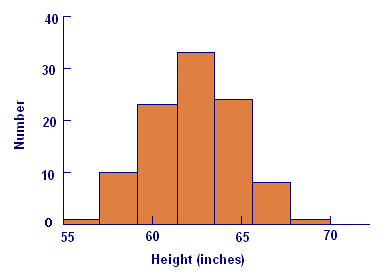Chapter 9
Probability and Integration
9.3 Continuous Probability
9.3.2 Histograms and Bell-Shaped Curves
A particularly important class of distributions for describing a wide range of phenomena is the class of normal distributions. The following are examples of data that tend to be distributed normally:
Repeated weighings of an object using the same device
Heights of individuals from a more or less homogeneous population
Test scores on ability or aptitude tests (e.g., IQ, SAT, GRE)
Data of this sort tend to cluster around the mean or average value, with similar numbers of values at equal distances above and below the average. For a given length, as you move away from the average, you find fewer and fewer values in an interval of that length. These properties don't completely characterize normal distributions — e.g., the Cauchy distribution has all these properties. However, we will quantify "clustering" and "spreading" in a way that distinguishes normal distributions from all others.

 We consider a data set that consists of heights of `100` women. Figure 3 shows a histogram plot of this data. A histogram is constructed in two steps:
We consider a data set that consists of heights of `100` women. Figure 3 shows a histogram plot of this data. A histogram is constructed in two steps:
First, subdivide an interval containing all the data values into a number of subintervals of equal length.
Then, on each subinterval, plot a bar whose height represents the number of data points that fall in that subinterval.
If the data are normally distributed, and if the number of subintervals is not too large or too small, the histogram will have the characteristic bell shape that you see in Figure 3.

If we have a large sample from a normally distributed population, the histogram should have roughly the same shape as the density function; the height of each bar is proportional to the fraction of data points that fall in the corresponding interval, and that fraction should be approximately the probability of a random data value lying in that interval.
Activity 3
-
Print a copy of Figure 3, and sketch on it a smooth, bell-shaped curve that should have the shape of the probability density function `f text[(] t text[)]`. (The scale won't be right because the areas of the bars are too large to be probabilities.)
Now make a rough sketch of the distribution function `F text[(] t text[)]`. All you need to know is that `F text[(] t text[)]` is an antiderivative of `f text[(] t text[)]`, together with the values that `F text[(] t text[)]` should have for very large and very small values of `t`.



